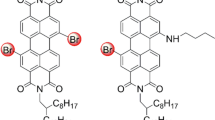Abstract
Kinetics of radical-ion pairs (RIPs) formed by photoinduced electron transfer in solution, as well as triplet and singlet products of their recombination, are studied within a general theory of spin-selective charge transfer assisted by diffusion of reactants in solution. The RIPs are assumed to be created in the singlet state, and their coherent singlet–triplet evolution is described in terms of isotropic hyperfine interaction (HFI) and \(\Delta g\) mechanisms. A set of quantum-classical model equations is solved numerically using the time propagator splitting technique. Numerical simulations are carried out on a prototype photochemical reaction involving bimolecular electron transfer between 9,10-dimethylanthracene (DMeA) and phthalonitrile (PN) in acetonitrile (ACN) solution. Time-dependent populations of all electronic and spin states, as well as spatial distributions of reactants in the course of forward and backward charge transfer are calculated and analysed. Particularly, spatial profiles of charge recombination (CR) in singlet and triplet RIPs are shown to differ significantly, with a significant part of the singlet RIPs undergoing distant (non-contact) recombination. The effect of a strong (saturating) magnetic field on the triplet CR product yield in these reactions is studied. For the HFI-induced coherent spin transitions, the time-dependent magnetic field effect is shown to decrease with time. A phenomenon of suppressing the triplet CR product yield in RIPs with the HFI- and \(\Delta g\)-induced coherent spin transitions in moderate magnetic fields is investigated and its physical origins are discussed.








Similar content being viewed by others
References
K.M. Salikhov, Y.N. Molin, R.Z. Sagdeev, A.L. Buchachenko, Spin Polarization and Magnetic Effects in Radical Reactions Akademian Kiado (Budapest) (Elsevier, Amsterdam, 1984)
A. Weller, Pure Appl. Chem. 54, 1885 (1982). https://doi.org/10.1351/pac198254101885
I.R. Gould, S. Farid, Acc. Chem. Res 29, 522 (1996). https://doi.org/10.1021/ar950053z
N. Mataga, H. Miyasaka, Adv. Chem. Phys. 107, 431 (1999). https://doi.org/10.1002/9780470141663.ch8
A. Rosspeintner, E. Vauthey, Phys. Chem. Chem. Phys. 16, 25741 (2014). https://doi.org/10.1039/C4CP03862B
K. Schulten, H. Staekand, A. Weller, H.J. Werner, B.Z. Nickel, Z. Phys. Chem. 101, 371 (1976). https://doi.org/10.1524/zpch.1976.101.1-6.371
Z. Schulten, K. Schulten, J. Chem. Phys. 66, 4616 (1977). https://doi.org/10.1063/1.433719
A. Weller, H. Staerk, R. Treichel, Faraday Discuss. Chem. Soc. 78, 271 (1984). https://doi.org/10.1039/DC9847800271
M. Ottolenghi, Acc. Chem. Res. 6, 153 (1973). https://doi.org/10.1021/ar50065a002
M.E. Michel-Beyerle, R. Haberkorn, W. Bube, E. Steffens, H. Schroeder, H.J. Neusser, E.W. Schlag, H. Seidlitz, Chem. Phys. 17, 139 (1976). https://doi.org/10.1016/0301-0104(76)80097-3
B. Brocklehurst, J. Chem. Soc. Faraday Trans. 72, 1869 (1976). https://doi.org/10.1039/F29767201869
H.J. Werner, H. Staerk, A. Weller, J. Chem. Phys. 68, 2419 (1978). https://doi.org/10.1063/1.436013
A.A. Neufeld, A.I. Burshtein, G. Angulo, G. Grampp, J. Chem. Phys. 116, 2472 (2002). https://doi.org/10.1063/1.1433746
G. Angulo, G. Grampp, A.A. Neufeld, A.I. Burshtein, J. Phys. Chem. A 107, 6913 (2003). https://doi.org/10.1021/jp0342475
V.S. Gladkikh, A.I. Burshtein, G. Angulo, G. Grampp, Phys. Chem. Chem. Phys. 5, 2581 (2003). https://doi.org/10.1039/B301009K
K.M. Salikhov, Chem. Phys. 82, 145 (1983). https://doi.org/10.1016/0301-0104(83)85353-1
D.V. Dodin, A.I. Ivanov, A.I. Burshtein, J. Phys. Chem. A 112, 889 (2008). https://doi.org/10.1021/jp077725a
A.I. Ivanov, A.I. Burshtein, J. Phys. Chem. A 112, 6392 (2008). https://doi.org/10.1021/jp800008n
D.V. Dodin, A.I. Ivanov, A.I. Burshtein, J. Chem. Phys. 138, 124102 (2013). https://doi.org/10.1063/1.4795576
A.I. Burshtein, A.I. Ivanov, J. Chem. Phys. 141(2), 024508 (2014)
S.V. Feskov, M.V. Rogozina, A.I. Ivanov, A. Aster, M. Koch, E. Vauthey, J. Chem. Phys. 150(2), 024501 (2019)
K. Möbius, W. Lubitz, A. Savitsky, Appl. Magn. Reson. 41(2), 113 (2011). https://doi.org/10.1007/s00723-011-0284-7
U.E. Steiner, T. Ulrich, Chem. Rev. 89, 51 (1989). https://doi.org/10.1021/cr00091a003
A.I. Burshtein, Chem. Phys. Lett. 194, 247 (1992). https://doi.org/10.1016/0009-2614(92)85542-I
R.C. Dorfman, M.D. Fayer, J. Chem. Phys. 96, 7410 (1992). https://doi.org/10.1063/1.462391
A.I. Burshtein, Adv. Chem. Phys. 114, 419 (2000). https://doi.org/10.1002/9780470141731.ch6
A. Rosspeintner, D.R. Kattnig, G. Angulo, S. Landgraf, G. Grampp, A. Cuetos, Chem. Eur. J. 13(22), 6474 (2007). https://doi.org/10.1002/chem.200700106
S.V. Feskov, A.I. Burshtein, J. Phys. Chem. A 113(48), 13528 (2009). https://doi.org/10.1021/jp901863t
G. Angulo, A. Rosspeintner, B. Lang, E. Vauthey, Phys. Chem. Chem. Phys. 20(39), 25531 (2018). https://doi.org/10.1039/C8CP05153D
A. Reymond, G.K. Fraenkel, J. Phys. Chem. 71, 4570 (1967). https://doi.org/10.1021/j100872a076
I.C. Lewis, L.S. Singer, J. Chem. Phys. 43, 2712 (1965). https://doi.org/10.1063/1.1697200
N.N. Lukzen, J.B. Pedersen, A.I. Burshtein, J. Phys. Chem. A 109, 11914 (2005). https://doi.org/10.1021/jp053539y
N. Korst, A. Lazarev, Physica 42(1), 31 (1969). https://doi.org/10.1016/0031-8914(69)90085-8
J.B. Pedersen, J.H. Freed, J. Chem. Phys. 58(7), 2746 (1973). https://doi.org/10.1063/1.1679576
J.B. Pedersen, J.H. Freed, J. Chem. Phys. 59(6), 2869 (1973). https://doi.org/10.1063/1.1680418
A.A. Kornyshev, J. Ulstrup, Chem. Phys. Lett. 126, 74 (1986). https://doi.org/10.1016/0009-2614(86)85119-3
R.A. Marcus, N. Sutin, Biochim. Biophys. Acta 811, 265 (1985). https://doi.org/10.1016/0304-4173(85)90014-X
K. Huang, A. Rhys, Proc. R. Soc. A 204, 406 (1950). https://doi.org/10.1098/rspa.1950.0184
S.V. Feskov, Math. Phys. Comput. Simul. 24(1), 50 (2021). https://doi.org/10.15688/mpcm.jvolsu.2021.1.4
M. Koch, G. Licari, E. Vauthey, J. Phys. Chem. B 119, 11846 (2015). https://doi.org/10.1021/acs.jpcb.5b07663
E. Pines, D. Huppert, N. Agmon, J. Chem. Phys. 88, 5620 (1988). https://doi.org/10.1063/1.454572
A.I. Burshtein, Adv. Chem. Phys. 129, 105 (2004). https://doi.org/10.1002/047168077X.ch3
F. Etzold, I. Howard, N. Forler, A. Melnyk, D. Andrienko, M. Hansen, F. Laquai, Energy Environ. Sci. 8, 1511 (2015). https://doi.org/10.1039/C4EE03630A
R.M. Williams, H.C. Chen, D.D. Nuzzo, S.C.J. Meskers, R.A.J. Janssen, J. Spectrosc. 2017, 1 (2017). https://doi.org/10.1155/2017/6867507
E.M. Espinoza, D. Bao, M. Krzeszewski, D.T. Gryko, V.I. Vullev, Int. J. Chem. Kinet. 51(9), 657 (2019). https://doi.org/10.1002/kin.21285
Funding
The work is supported by the Russian Foundation for Basic Research (project No. 19-03-00175).
Author information
Authors and Affiliations
Corresponding author
Additional information
Publisher's Note
Springer Nature remains neutral with regard to jurisdictional claims in published maps and institutional affiliations.
Rights and permissions
About this article
Cite this article
Feskov, S.V., Ivanov, A.I. Short-Time Dynamics of Radical-Ion Pairs Produced by Photoinduced Electron Transfer in Solution: The Magnetic Field Effect. Appl Magn Reson 53, 745–761 (2022). https://doi.org/10.1007/s00723-021-01388-1
Received:
Revised:
Accepted:
Published:
Issue Date:
DOI: https://doi.org/10.1007/s00723-021-01388-1



